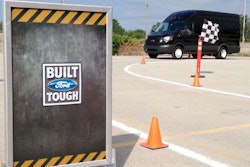Ford has been granted an exemption from the Federal Motor Carrier Safety Administration (FMCSA) for Transit vans, whose exhaust system location do not meet federal requirements.
Federal Motor Carrier Safety Regulations (FMCSRs) require the exhaust system of a bus powered by a gasoline engine to discharge to the atmosphere “at or within six inches forward of the rearmost part of the bus; and the exhaust system of every truck and truck tractor to discharge to the atmosphere at a location to the rear of the cab or, if the exhaust projects above the cab, at a location near the rear of the cab.”
While Ford’s Transit does not meet these requirements, FMCSA cited Transit’s extensive performance-based testing as a deciding factor in granting the exemption. Testing has shown the exhaust system achieves a level of safety equivalent to or greater than the level of safety that would be obtained by complying with the regulation, the agency noted.
“. . . Ford’s requirements address passenger compartment exhaust gas intrusion and management of high temperature components,” Ford wrote in its request for exemption. “These requirements include testing of the system and basic design requirements for the location of the tailpipe in relation to underbody components like the brake lines and fuel lines.
“Ford has performed carbon monoxide (CO) concentration tests which used CO monitors at various locations within the vehicle to measure the concentration of CO ingress into the occupant compartment (from the vehicles’ own powertrain and exhaust system) under various driving conditions including idle and top speed,” FMCSA wrote in its bulletin. “The tests showed that the resulting CO concentration is below every threshold used by Federal agencies. FMCSA has concluded that the limited 2-year exemption will achieve a level of safety equivalent to or greater than the level of safety provided by the rule restricting the location of exhaust systems on CMVs to ensure that exhaust fumes will not affect the driver’s alertness or health or the health of passengers.”











